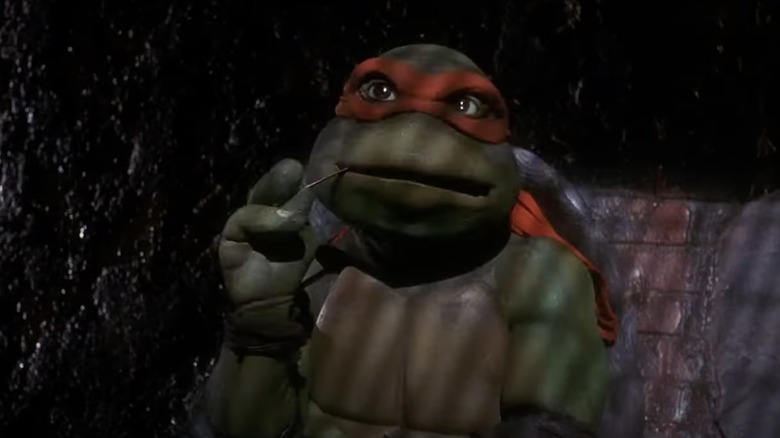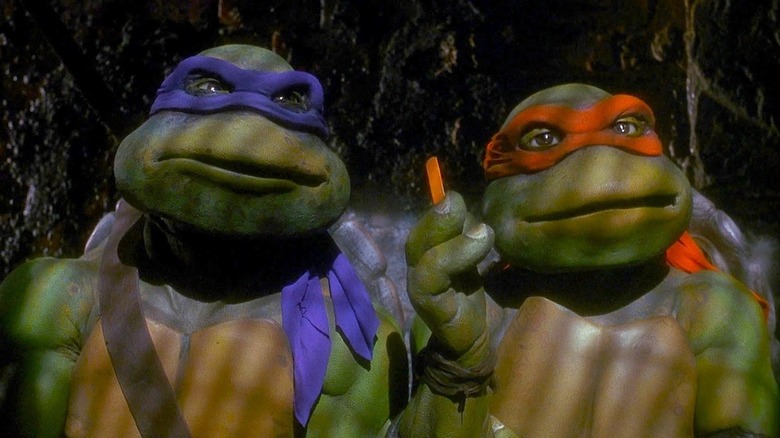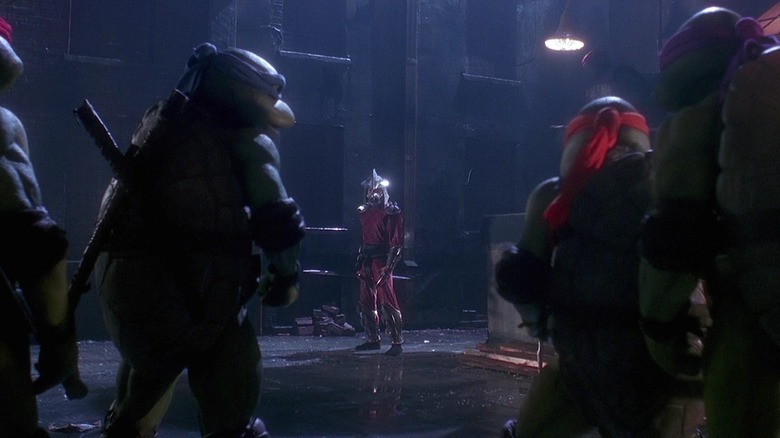One Very Strategic Decision Set The Teenage Mutant Ninja Turtles Up For Success
Over 30 years on, it's hard to overstate just how big "Teenage Mutant Ninja Turtles" and the resulting Turtlemania were back in the day. One minute, everyone in the school playground was doing swapsies with Garbage Pail Kids and Panini football stickers, the next, it was all "Teenage Mutant Hero Turtles." Yes, you read that correctly; in the UK, the powers-that-be deemed the word "Ninja" too violent, so "Hero" was swapped in instead. On top of that, Michelangelo's nunchucks were replaced by a grappling hook, a baffling decision because you still had Leonardo's swords and Raphael's three-pronged Sai, both of which were arguably more deadly than two lumps of wood connected by a chain.
In the school lunchroom, the usual motley collection of "The A-Team," "Star Wars," and "He-Man" lunchboxes was quickly overtaken by shiny new Turtles ones. There were comic books, cartoons, action figures, and video games; everyone with a Nintendo pretended to like the rock-hard tie-in even though it sucked, and the awesome four-player beat-em-up was always rammed in the arcades.
Then the live-action movie hit theaters in 1990 and we hit peak Turtlemania. The song "Turtle Power" by Partners in Kryme from the soundtrack was the first hip-hop single to reach number one in the UK charts and became a staple of school discos and kids' birthday parties across the land. You simply couldn't get away from the Turtles at that point.
In short, the Turtles were a true cultural phenomenon, taken to blockbuster proportions by the enormous success of the first movie. Yet the film might not have become such a hit if it wasn't for one bold decision on when and how to release the movie.
From humble beginnings to world dominion
The rise of "Teenage Mutant Ninja Turtles" is a remarkable underdog story. The bandana-wearing reptiles were the brainchild of Kevin Eastman and Peter Laird, starting back in 1983 with a simple sketch of a nunchuck-wielding turtle. Their comic book started out as a joke, but they both liked the concept and developed it into a comic book parodying superhero tropes.
The duo formed their own company in Laird's living room, named Mirage Studios. They scraped enough money together for an initial run of 3000 copies and used their last few bucks to place an advert in a comic industry magazine. Every copy sold in a matter of weeks, kickstarting a franchise that would lead to a 30-year comic book run and all the adaptations and merchandise that would accompany the snowballing and never-ending fandom.
The pinnacle was the 1990 feature film that became the most successful independent film ever made at the time. Several major studios passed on the concept because, "Batman" aside, comic book adaptations were considered box office poison, thanks to the likes of "Howard the Duck." Up-and-coming indie studio New Line Cinema wisely took a punt and history was made.
As for the film itself, whether it was good or not was almost beside the point. Aimed squarely at its youthful target audience, it was a routine crowdpleaser miles better than the competition, giving fans all they needed with plenty of action, pizza, and wisecracks. The best part was the Turtle design by Jim Henson's Creature Shop, still far more endearing than the disturbing CG iterations in the charmless 2014 reboot.
The Turtles break box office records
"Teenage Mutant Ninja Turtles" opened on 30 March 1990, a date that was to the film's enormous success at the box office. Earlier in the month, "The Hunt for Red October" broke the record for a non-holiday release, opening with $17 million. That milestone was short-lived when the Turtles somersaulted into theaters, shattering the record with a $25 million opening weekend.
"Turtles" romped home with over $200 million worldwide against a relatively modest budget of $13.5 million (via Box Office Mojo), finishing the year as the fourth-highest grossing movie domestically behind "Ghost," "Pretty Woman," and "Home Alone." Tom Gray of Golden Harvest (one of the companies investing in the film) attributed its success to the foresight of the distributors (via Hollywood Reporter):
"It was the brilliance of [New Line distribution exec] Mitch Goldman and New Line to get that date. The theory was, if we opened on a non-holiday, we'd have a big opening. We'd get the fans on the first weekend and on the second weekend — and we'd have almost no dropout midweek as the fans went out in droves. It proved to be absolutely the key, and that momentum carried into the $135 million."
The film spawned two sequels, but Turtlemania had already peaked. Nowadays, it's quaint looking back at a time when superhero movies were almost an anomaly rather than the norm, well before "The Dark Knight" and "Iron Man" transformed the way comic book adaptations were presented on the big screen. Yet for a while there, a knockabout movie about four turtles named after Renaissance artists, trained as ninjas by a rat, living in the sewers of New York and feasting on pizza, was the biggest thing in our young lives. Put that way, it sounds like it was all some weird dream.


